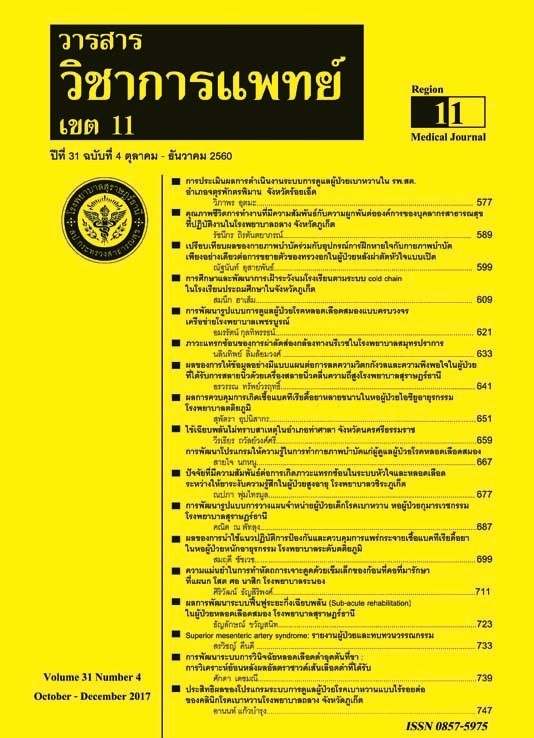Guidelines Implementation for the Prevention and Control of Multidrug Resistant Bacteria in Medical Intensive Care Unit
Keywords:
Guideline Implementation, Multidrug-resistant bacteria, 4Es ModelAbstract
Introduction : Hospital associated infection with multidrug-resistant (MDR) bacteria is increasing. Compliance of health care team may help prevent MDR bacterial in hospitals.
Objective : To compare nurses’ s compliance to the prevention and control of MDR bacteria guidelines and the rate of MDR bacteria including the issues before and after implementing the guidelines in a medical intensive care unit (MICU) of a tertiary care hospital.
Method : This is a quasi-experimental one-group, pretest-posttest study. The guidelines implementation was guided by the Change model or 4Es model (Engage, Educate, Execute and Evaluate). Data were collected from medical records of inpatients admitted in MICU during July to September 2016, prior to (n=26) and after (n=37) its implementation.The research instruments included the patient data recording form and prevention and control MDR bacteria observe form. Data were analyzed using by descriptive statistics, Wilcoxon Signed Rank test and Chi square.
Result : The findings showed that utilizing the 4Es model as a means to implement the guidelines significantly improved compliance (p<002). Some actions were not changed significantly. These included wearing gloves when touching the patient, bedside equipment, blood or secretions and wearing a gown when the body touches the patient closely. The rates of MDR bacteria were not statistically different (p>.05).
Conclusion : The 4Es model can lead to guidelines compliance. However, this should be monitored and followed up to enhance sustainability of the guidelines implementation.
References
2. World Health Organization. Summary of the latest data on antibiotic resistance in the European Union. [online].2013. [cited 2016 April 2], Available from: http://ecdc.europa.eu/en/ publications/_layouts/forms/Publication_ DispForm.aspx?List=4f55ad51-4aed-4d32-b960-af70113dbb90&ID=1205
3. Kumar SG et al. Antimicrobial resistance in India: A review. [online]. 2013. [cited 2016 April 2], Available from: http://www.ncbi.nlm.nih.gov/pmc/articles/PMC3783766
4. ศูนย์เฝ้าระวังเชื้อดื้อยาต้านจุลชีพแห่งชาติ. สถานการณ์ความไวของเชื้อต่อยา. [ออนไลน์].2558. [cited 2016 April 2], Available, from: http://narst.dmsc.moph.go.th
5. วีรพงศ์ วัฒนาวนิช, พรรณทิพย์ ฉายากุล. การติดเชื้ออะซินีโตแบคเตอร์ในผู้ป่วยที่รับการรักษาในหออภิบาล. วารสารสงขลานครินทร์เวชสาร; 2556; 31(2), 91-100.
6. ชมรมป้องกันและควบคุมการติดเชื้อในโรงพยาบาล. แนวทางปฏิบัติการป้องกันและควบคุมเชื้อก่อโรคดื้อยา. ชมรมควบคุมการติดเชื้อในโรงพยาบาล. พิมพ์ครั้งที่ 1. กรุงเทพฯ: สำนักงานพระพุทธศาสนา; 2557 หน้า 1-3.
7. Chan, Chi Fun. Molecular Epidermiology of Methicillin-Resistant Staphylococcus aureus in Patients and their Surrounding Environment. Thesis of Microbiology of the University of Hong Kong in partial fulfillment of the requirements for the Degree of Master of Medical Sciences.[online]. 2012. [cited 2016 April 2], Available from: from http://hub.hku.hk/bitstream/10722/173920/1/FullText.pdf
8. คณะกรรมการป้องกันและควบคุมการติดเชื้อในโรงพยาบาลวชิระภูเก็ต. รายงานการเฝ้าระวังการติดเชื้อในโรงพยาบาลปี 2557. งานป้องกันและควบคุมการติดเชื้อในโรงพยาบาลวชิระภูเก็ต.
9. คณะกรรมการป้องกันและควบคุมการติดเชื้อในโรงพยาบาลวชิระภูเก็ต. แนวทางปฏิบัติการป้องกันการติดเชื้อแบคทีเรียดื้อยาปี 2557. งานป้องกันและควบคุมการติดเชื้อในโรงพยาบาลวชิระภูเก็ต.
10. คณะกรรมการป้องกันและควบคุมการติดเชื้อในโรงพยาบาลวชิระภูเก็ต. รายงานการเฝ้าระวังการติดเชื้อในโรงพยาบาลปี 2558. งานป้องกันและควบคุมการติดเชื้อในโรงพยาบาลวชิระภูเก็ต.
11.Pronovost PJ. Creating High Reliability in Health Care Organizations.[online]. 2006. [cited 2016 July 4], Available from: http://www.ncbi.nlm.nih.gov/pubmed/16898981
12. ภัทรชัย กีรติสิน, อนุชา อภิสารธนรักษ์. Beta-lactamase ในแบคทีเรียแกรมลบ จากความรู้พื้นฐานสู่เวชปฏิบัติ. พิมพ์ครั้งที่ 1 กรุงเทพฯ: วี.เจ. พริ้นติ้ง; 2555. หน้า 166-186.
13. Center for Disease Control and Prevention. MDRO Prevention and Control. [online].2006. [cited 2016 December 3], Available from:http://www.cdc.gov/hicpac/pdf/MDRO/Pages11_28MDROGuideline2006.pdf.
14. Suthat R, Charurat S, Termkiat K. Acinetobacter Infection in the Intensive Care Unit. Journal of Infectious Disease and Antimicrobial Agents; 2005; 22(2): 77-92.
15. ปิยะฉัตร วิเศษศิริ, อะเคื้อ อุณหเลขกะ, นงเยาว์เกษตรภิบาล, การพัฒนารูปแบบการส่งเสริมการปฏิบัติการป้องกันการติเชื้อดื้อยาของบุคลากรพยาบาล แผนกอายุรกรรมในโรงพยาบาลระดับตติยภูมิ, พยาบาลสาร 2558; 42 (3): 119-134.
16. Apisanthanarak A, Khawcharoenporn T, Mundy LM. Practices to prevent multidrug-resistant Acinetobacter baumannii and methicillin-resistant Staphylococcus aureus in Thailand: a national survey. AJIC; 2013 ; 41(5): 416-21.
17. Haga Y. Central venous catheter-related infection.[online]. 2011. [cited 2016 December 3]. Available f rom: https://www.ncbi.nlm.nih.gov/pubmed/21485103.
18. Pronovost P. Intrventions to decrease catheter-related bloodstream infections in the ICU: the Keystone Intensive Care Unit Project.[online]. (2008). [cited 2016 December 17]. Available from: https://www.ncbi.nlm.nih.gov/pubmed/19084146.
19. กิตติรัตน์ สวัสดิ์รักษ์, อะเคื้อ อุณหเลขกะ, วันชัย เลิศวัฒนวิลาศ. อุปสรรคและสิ่งสนับสนุนการปฏิบัติการป้องกันการติดเชื้อของพยาบาลวิชาชีพโรงพยาบาลระดับตติยภูมิ, พยาบาลสาร; 2558; 42 (4): 25-35.






